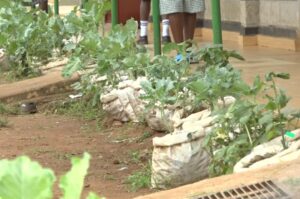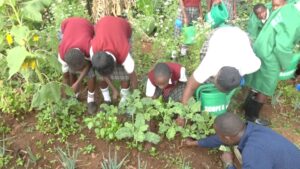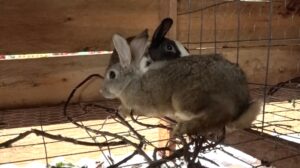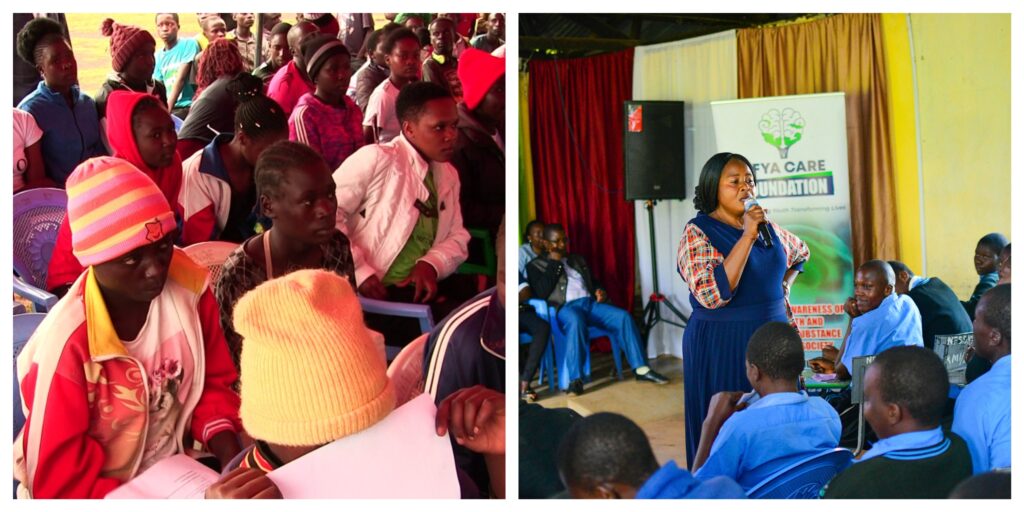Cultural inheritance practices, urbanization, and population growth form part of the factors that have resulted in land fragmentation in Kenya. Consequently, the effects of land fragmentation have been agriculturally unfavourable. Big chunks of fertile land have been subdivided into smaller, uneconomical portions, a practice that has threatened food security by reducing agricultural productivity.
In Kenya, agriculture is the main economic driver; however, it is vulnerable to unprecedented climatic shocks. Severe droughts are usually followed by heavy rains and flooding, which degrade the available farmlands.
According to the World Food Programme (WFP) World Food Programme (WFP), 38.6% of people live below the poverty line, while 29% of children in rural areas are stunted. To address the challenges posed by limited food supplies, schools have adopted practical farming practices.
Formerly, stunning and fragrant flowers have been used to decorate homesteads and learning institutions. Colourful flowers have long been aesthetically used to landscape and partition compounds in residential areas and institutions without factoring in any economic value. With the introduction of the Competency-Based Curriculum (CBC) in Junior schools, practices aimed at filling the national food basket have been integrated into studies. Learners have been trained to productively use resources at their disposal.

Schools are increasingly transforming their flower gardens into kitchen gardens and orchards to capitalize on the economic benefits and achieve self-sufficiency. After all the efforts, Sis. Milrod Akinyi, Headteacher of Sega Girls Primary and Junior School in Ugenya Sub-County, Siaya County, is thrilled with the new look in the school.
“We realized that planting flowers is just for beauty, nothing else. Planting vegetables is more beneficial to human growth than what the eyes see. Even so, when vegetables are planted well, they will still present a beautiful image”, stated Milrod
“The school looks so beautiful with vegetables planted along the pathway. Parents admire our school, and other children usually come to see our school”, said Janelle Akinyi, a grade 9 learner at Sega Primary.
At first glance, a Beehive of activities are ongoing in the Sega Primary school compound. Pupils are busy watering plants such as: Kales, Banana seedlings, Sunflowers, Onions, Arrowroot, among others. The emergence of the new curriculum in primary and junior schools has borne new approaches to landscaping, where the economic aspect has been upheld. To sustain the fight on food security and to end the challenge of capitation, schools are replacing flowers with edible plants. Primary school children are trained to utilize the available small pieces of land for value addition by planting foodstuffs such as vegetables that can be commercialized or internally consumed instead of just flowers whose benefit ends at beautification.

Harriet Nichole, one of the learners, confidently expressed herself as she recounted how beneficial SCOPE Kenya has been to their school and to the surrounding village in terms of food supply.
“Permaculture means planting different kinds of crops in the same land. This has helped us as we no longer buy food from outside”, said Harriet
Sega Primary is a beneficiary of Schools and Colleges Permaculture (SCOPE), a programme which integrates Competency Based Education (CBE) class work and field practical. With their small piece of land, the school plants assorted crops, a move aimed at cushioning them against a food crisis resulting from delayed capitation from the government
“SCOPE encourages us that we don’t plant just one particular type of crop”, says Milrod, who reiterates that artificial fertilizer is not good for the soil.
SCOPE is a Kenyan network organization that comprises civil society groups/ non-governmental organizations whose vision is to equip Kenyan schools with knowledge on sustainable land use. SCOPE’s effort focuses on environmental improvement, food security and livelihood boost. Since its inception, 12 schools, 16 organizations, 12 counties, 1200 pupils, 120 teachers and 360 parents have been impacted.
Sega Primary in Siaya County has formed part of SCOPE’s success stories. Along the busy paths within the school compound are a series of folded bags piled with sand. Inside the bags, erect green leaves of kale and onions. These green and healthy-looking vegetables are free from artificial fertilizer and pesticides, which Milrod says kill the soil nutrients over time. The school relies on organic manure drawn from their one cow and a calf, which does not usually meet their high demand.
“If you plant crops such as marigolds and natural onions, they will send pests away. When you use natural fertilizer, crops grow well and the land remains fertile,” says Milrod, who explains the hassle they undergo to source organic manure externally to meet their demand.
To create a permanent solution to a recurrent organic manure shortage, the school has initiated a project to make compost manure internally. With the increased manure supply, the school is aiming at expanding the farmland to become fully reliant in terms of food supply.

According to AfricaFertilizer, between January and March of 2023, Kenya imported 426,038 bags of fertilizer, the lowest since 2018. 2020 recorded the highest figure with 834,549 bags imported. The above figures show that Kenya values artificial fertilizer, which, according to Milrod, erodes the soil nutrients.
“This project has really improved our school diet. We always eat nutritious food, and it has helped the school in cost-cutting”, said Janelle Akinyi, a grade one Pupil at Sega Primary
It is not just the economic benefit, the crops that the school plants also have medicinal value to the learners. Milrod declares that the ornamental flowers have intentionally been replaced with crops like Cucumber and the green tree grass, which she says sweetens the beverage and reduces stress when consumed. The green tree grass also acts as a mosquito repellent, states Milrod.
It does not just end at crops; the school also practice poultry farming. Within the school compound are henhouses and hutches where rabbits are reared. Milrod attest that this practice inculcates patience, teamwork and a sense of responsibility in learners as they routinely tend to crops and poultry.
“My children have even nicknamed rabbits human names. Planting these crops and seeing them grow to maturity instils the spirit of patience in them.”, says Milrod
Amidst the persistent financial constraint propagated by delayed capitation from the national treasury, the Sega school calendar often progresses uninterrupted as learners feed from its rich supply. From harvesting for domestic use to commercial reasons, the school is undoubtedly on a road to economic self-reliance.
“If you look at the way learners feed, we do not experience any food-related scarcity. We even use sunflowers to produce cooking oil, and sunflower wastes are used as chicken food,” said the support staff
“Rarely do we feed on bread. For breakfast, we feed on our sweet potatoes and all other natural food from our farm”, says Milrod, who reiterates that they do not encourage processed food in school.
Sega Primary’s strength in food production comes at a time when most schools in the semi-arid parts of Kenya are on the brink of closure due to food shortage prompted by harsh climatic conditions. Speaking while in Garissa on 6/09/2024, KNUT officials petitioned the government to disburse funds to support the school feeding programme to evade the enormous challenges that lack of funds in schools presents.
“We are in a dry spell season, and exams are forthcoming in October. The worst part is that the school feeding programme is no longer available”, said Garissa KNUT officials who urged Wajir, Mandera and Garissa Governors to come together and salvage the dire situation.
In Nairobi, feeding programmes have been rolled out to keep learners in School. The incumbent Nairobi Governor’s “Dishi na County project” was rolled out to address the challenges that Sega Primary is addressing on the farm. This flagship project is aimed at improving school attendance. The embattled project ensures that all learners, regardless of their socioeconomic background, have access to nutritious meals.
Sega primary on the other hand, is proving that it is possible in the farm and encouraging other schools to follow suit. To shield the school from financial crisis, Sega school commercializes the surplus of its products to villagers. Over the holiday period, when learners are on break, villagers throng the school compound to buy vegetables, and the earned cash is used to supplement the diet when school opens. Even though school holidays present an opportunity to commercialize the harvest, it in equal measure present a challenge as long as learners who work on the farms stay away.
“The late disbursement of capitation does not affect us much because we do not solely rely on it to feed our children. We usually convert our harvest into money to meet specific demands”, says Milrod
Amid challenges of food scarcity and continuous pressure on the government to provide capitation to fund the school feeding programme, SCOPE Kenya, in partnership with Sega Primary, has proved that institutions can be at the frontline in ending world hunger. Milrod has encouraged more schools to emulate Sega Primary in producing an adequate food supply, which in turn will suppress truancy. To amplify the need for more such projects, Milrod has encouraged the government to construct water points in schools, as farming requires a steady water supply.
“This project requires water, and the good thing about it is that once it picks, you will not spend a lot of money on food”, reiterated Milrod.
“I can advise other schools to start the project. I have learnt that you do not need a big land to do this, just creatively use the available piece of land”, said Janelle


